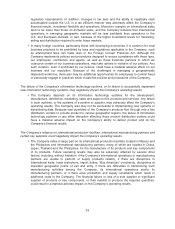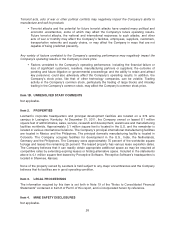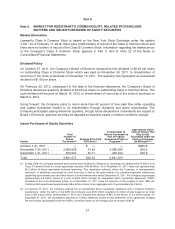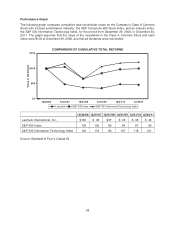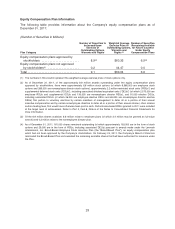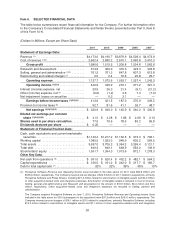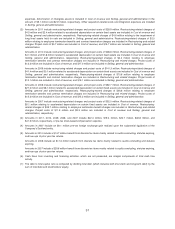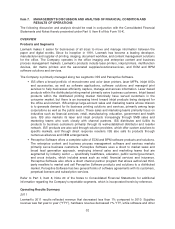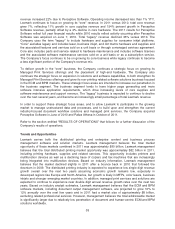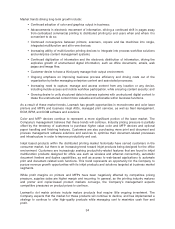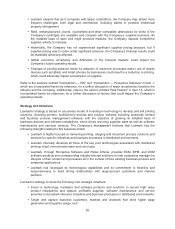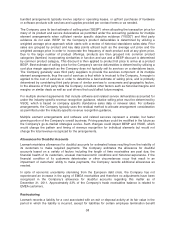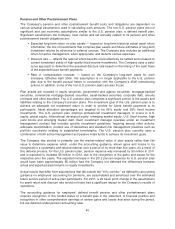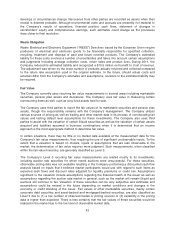Lexmark 2011 Annual Report Download - page 37
Download and view the complete annual report
Please find page 37 of the 2011 Lexmark annual report below. You can navigate through the pages in the report by either clicking on the pages listed below, or by using the keyword search tool below to find specific information within the annual report.revenue increased 22% due to Perceptive Software. Operating income decreased less than 1% YTY.
Lexmark continues to focus on growing its “core” revenue. In 2011 versus 2010, total core revenue
grew 7%, reflecting 11% growth in core supplies revenue and 154% percent growth in Perceptive
Software revenue, partially offset by a 4% decline in core hardware. The 2011 results for Perceptive
Software reflect full year financial results while 2010 results reflect activity occurring after Perceptive
Software was acquired on June 7, 2010. Total “legacy” revenue declined 35% versus 2010. The
Company uses the term “legacy” to include hardware and supplies for consumer inkjet platforms.
“Core” excludes legacy and includes laser, business inkjet, and dot matrix hardware and supplies and
the associated features and services sold on a unit basis or through a managed services agreement.
Core also includes parts and service related to hardware maintenance and includes software licenses
and the associated software maintenance services sold on a unit basis or as a subscription service.
The Company’s focus continues to be on growing its core business while legacy continues to become
a less significant portion of the Company’s revenue mix.
To deliver growth in the “core” business, the Company continues a strategic focus on growing its
Managed Print Services offerings and the placement of high-end hardware. The Company also
continues the strategic focus on expansion in solutions and software capabilities, to both strengthen its
Managed Print Services offerings and grow its non-printing related software solutions business focused
in the ECM and BPM markets. These strategic focus areas are intended to increase our penetration in
the business segment. The business segment tends to have higher page generating and more
software intensive application requirements, which drive increasing levels of core supplies and
software maintenance and support revenue. The “legacy” business is expected to continue to decline
over the next several years, and become an increasingly small percentage of total Lexmark revenue.
In order to support these strategic focus areas, and to allow Lexmark to participate in the growing
market to manage unstructured data and processes, and to build upon and strengthen the current
industry-focused document workflow solutions and managed print services, the Company acquired
Perceptive Software in June of 2010 and Pallas Athena in October of 2011.
Refer to the section entitled “RESULTS OF OPERATIONS” that follows for a further discussion of the
Company’s results of operations.
Trends and Opportunities
Lexmark serves both the distributed printing and enterprise content and business process
management software and solution markets. Lexmark management believes the total market
opportunity of these markets combined in 2011 was approximately $90 billion. Lexmark management
believes that the total distributed printing market opportunity was approximately $82 billion in 2011,
including printing hardware, supplies and related services. This opportunity includes printers and
multifunction devices as well as a declining base of copiers and fax machines that are increasingly
being integrated into multifunction devices. Based on industry information, Lexmark management
believes that the market declined slightly in 2011 after a bounce back in 2010 that followed the
downturn in 2009. The distributed printing industry is expected to experience low single digit revenue
growth overall over the next two years assuming economic growth remains low, especially in
developed regions like Europe and North America, but growth is likely in MFPs, color lasers, business
inkjets and stronger emerging market countries. In addition, managed print services and solutions are
expected to continue to experience near double digit annual revenue growth rates over the next two
years. Based on industry analyst estimates, Lexmark management believes that the ECM and BPM
software markets, including document output management software, are projected to grow 10% to
12% annually over the next few years and in 2011 had a market size of approximately $8 billion,
excluding related professional services. However, management believes the total addressable market
is significantly larger due to relatively low penetration of document and human-centric ECM and BPM
solutions worldwide.
33


